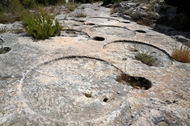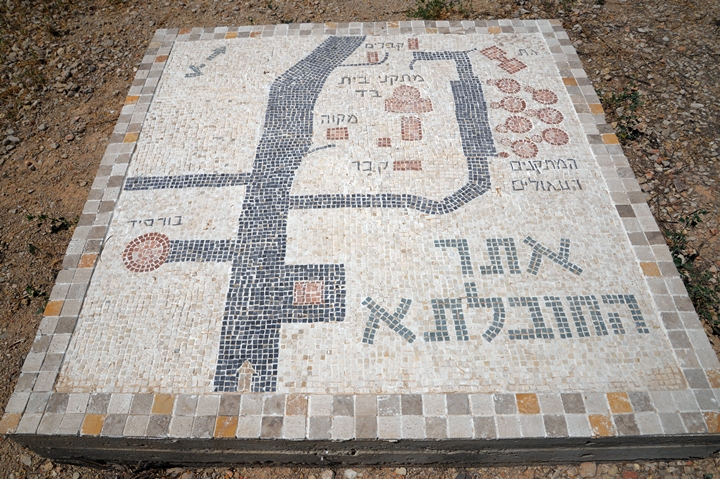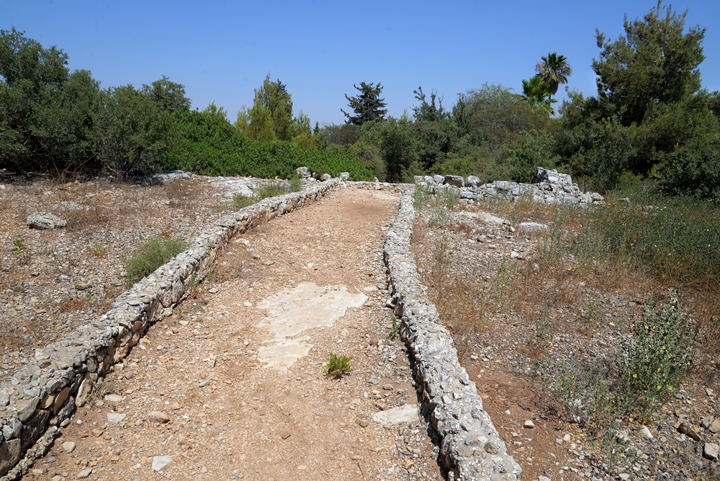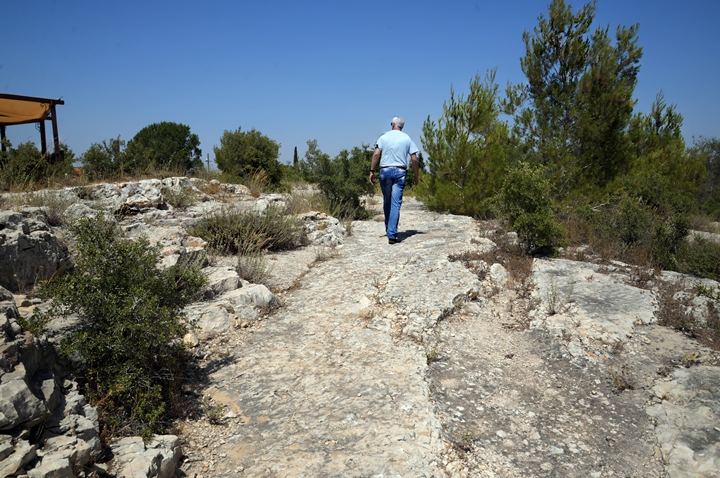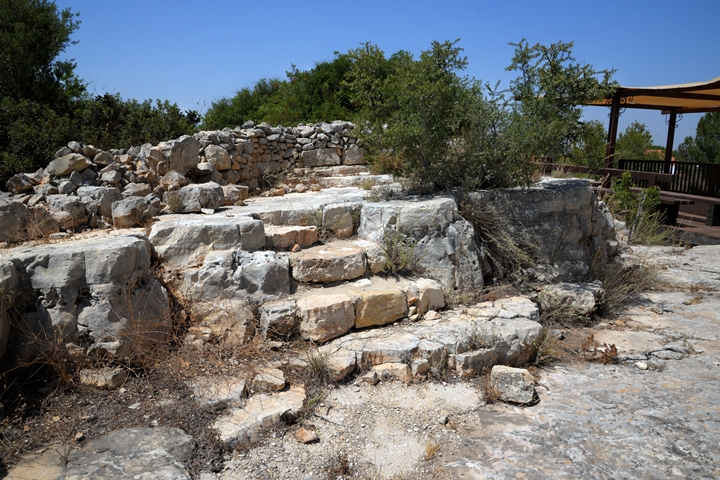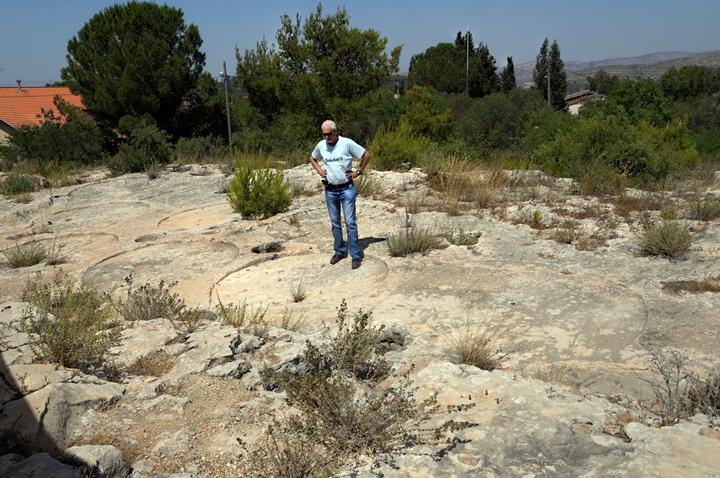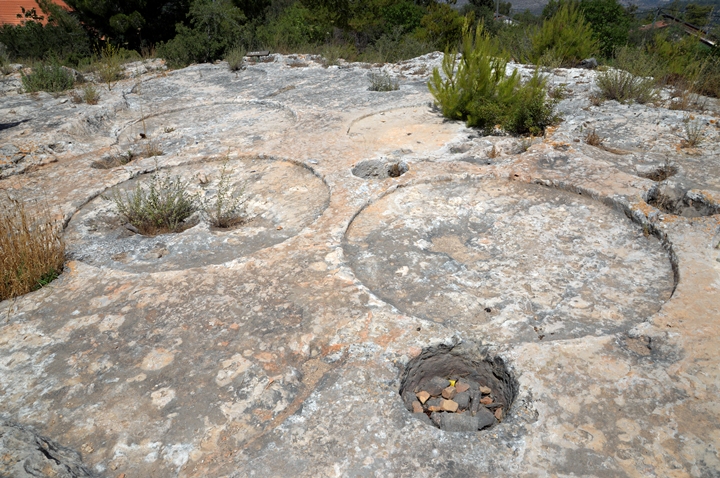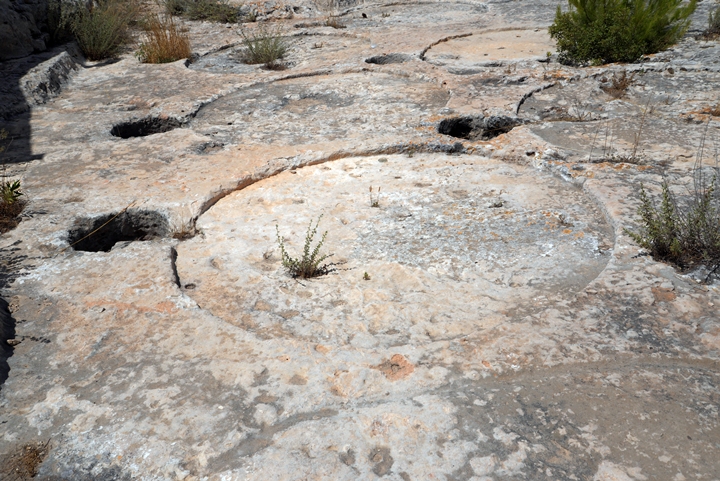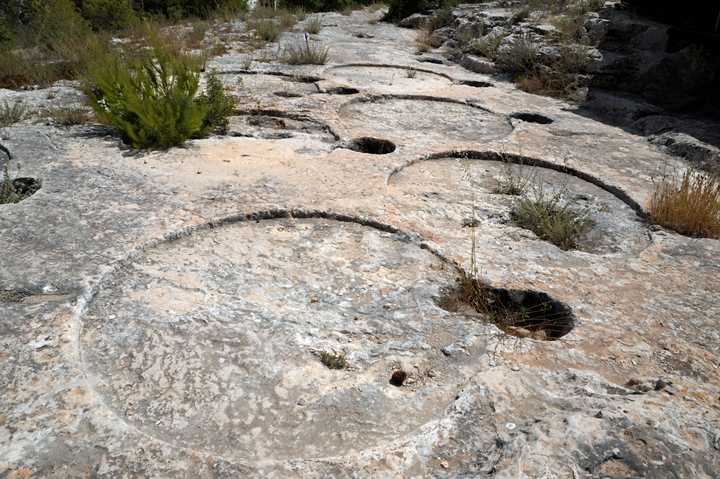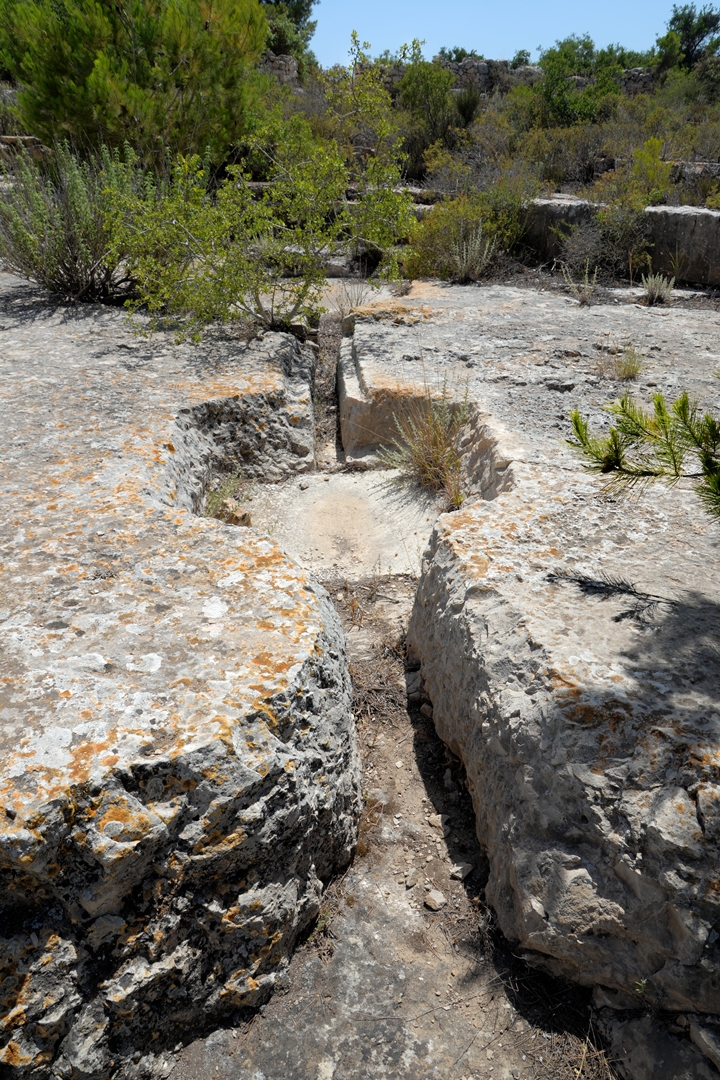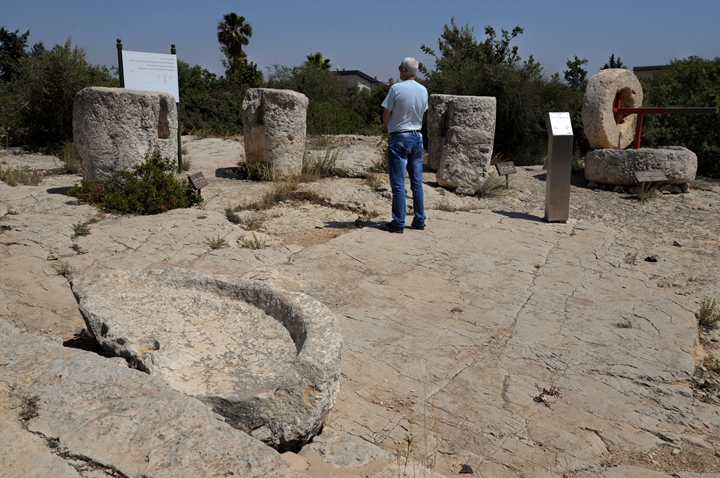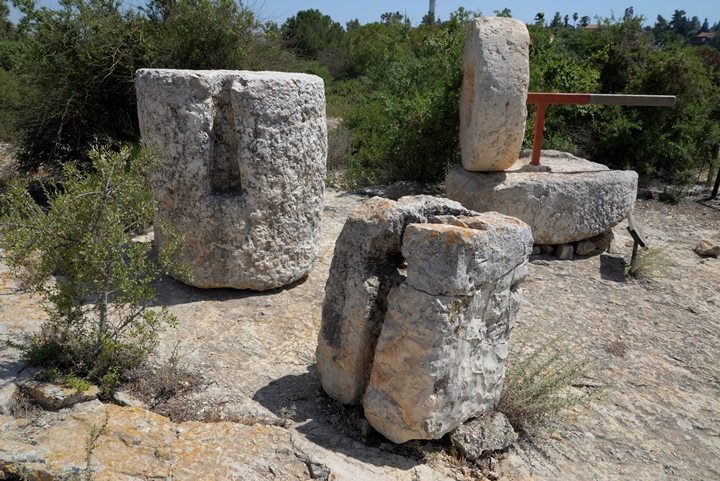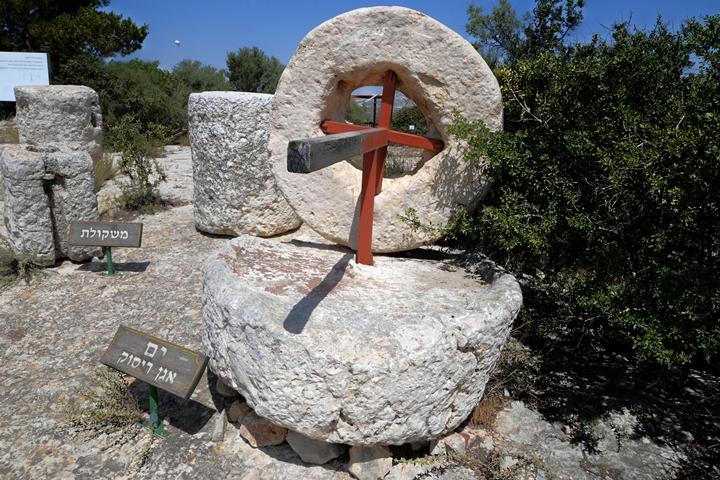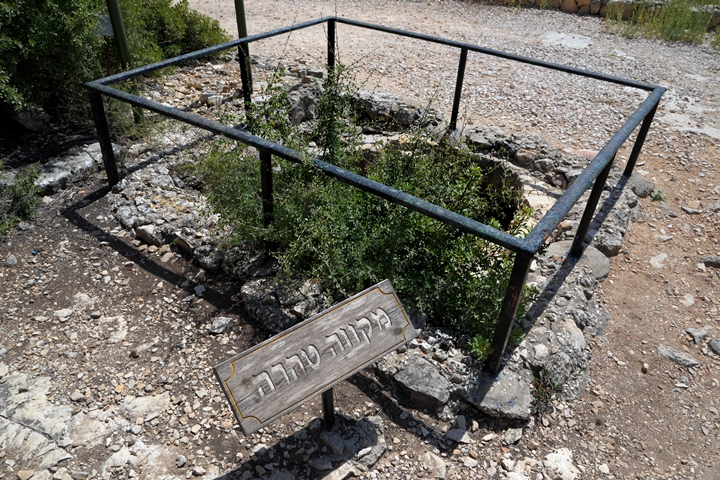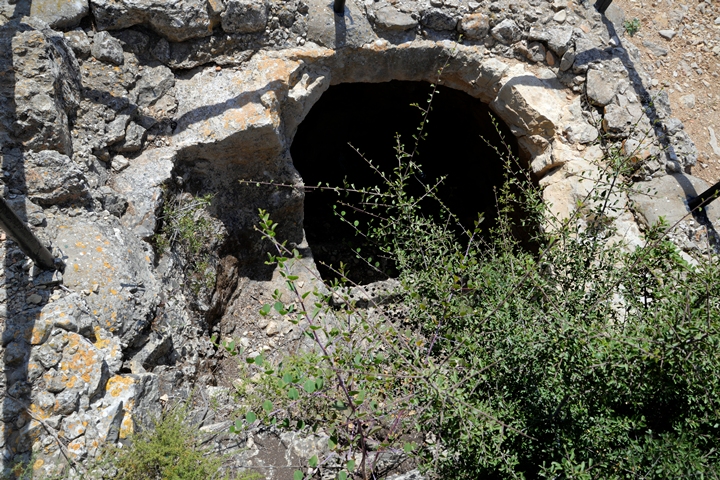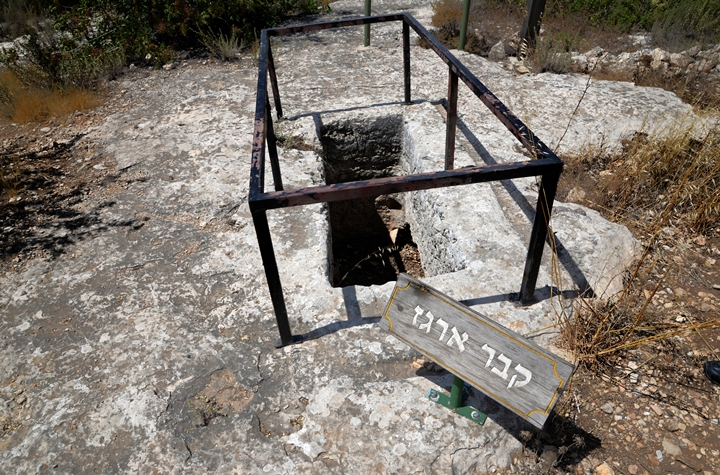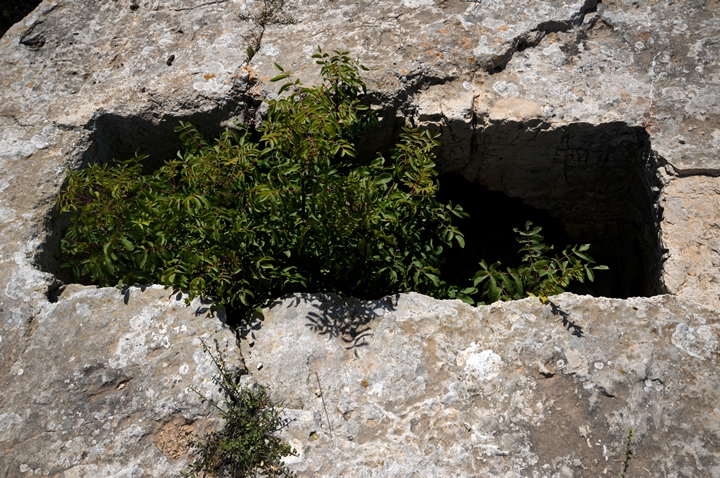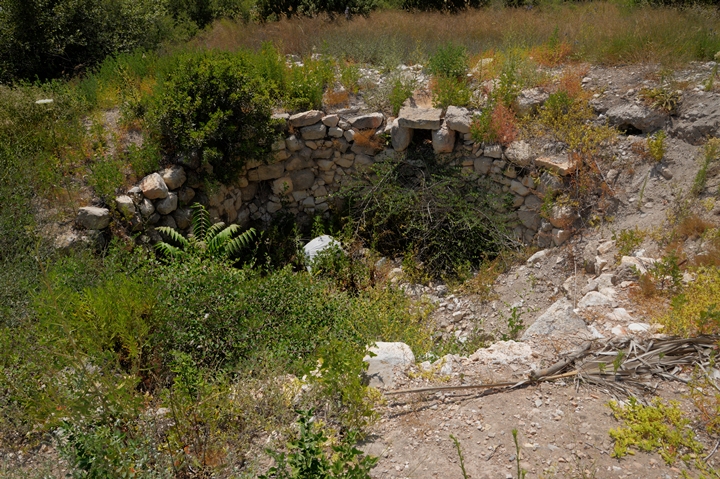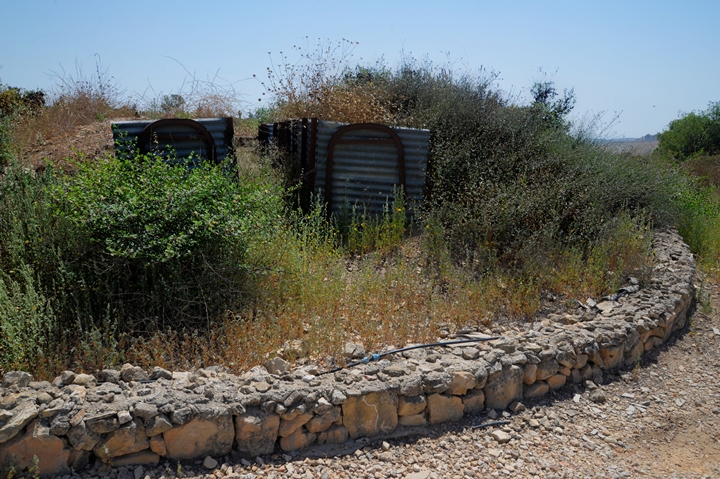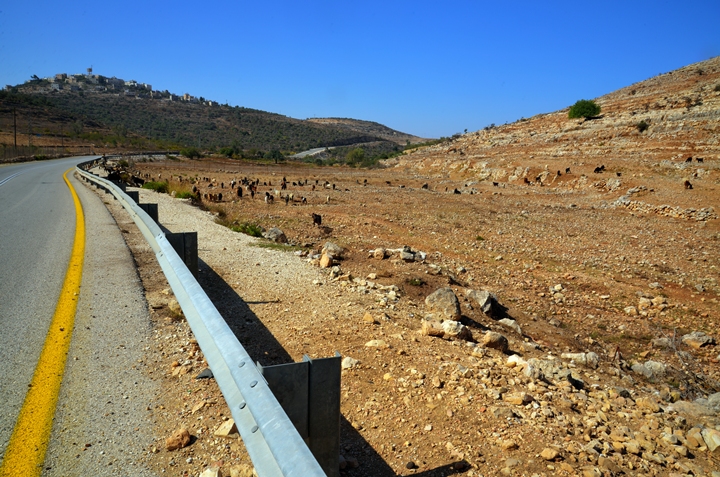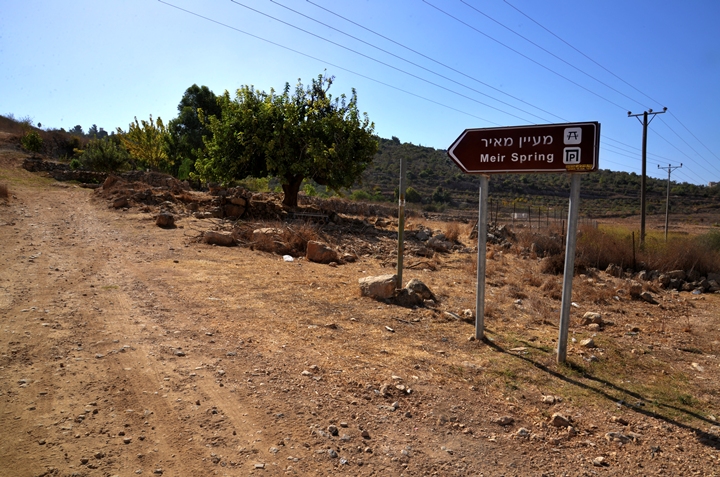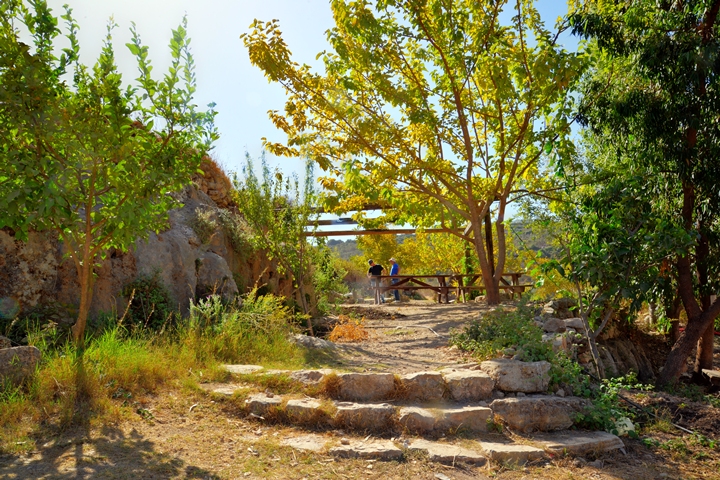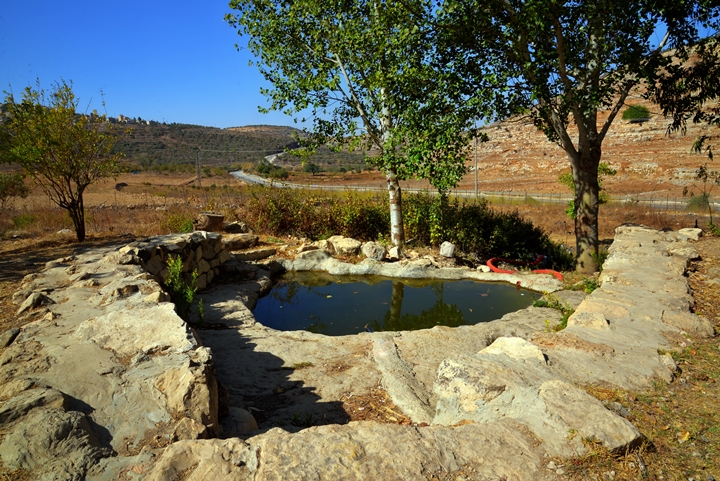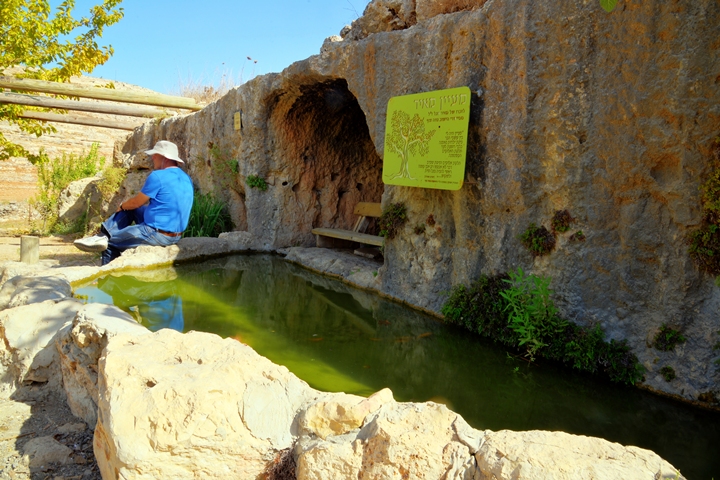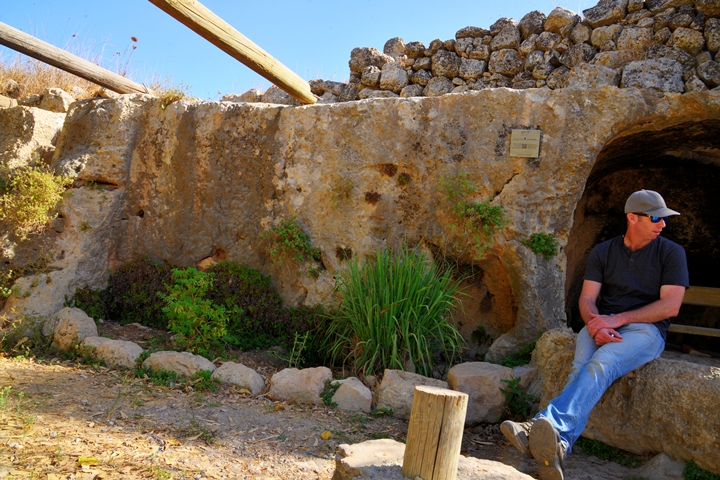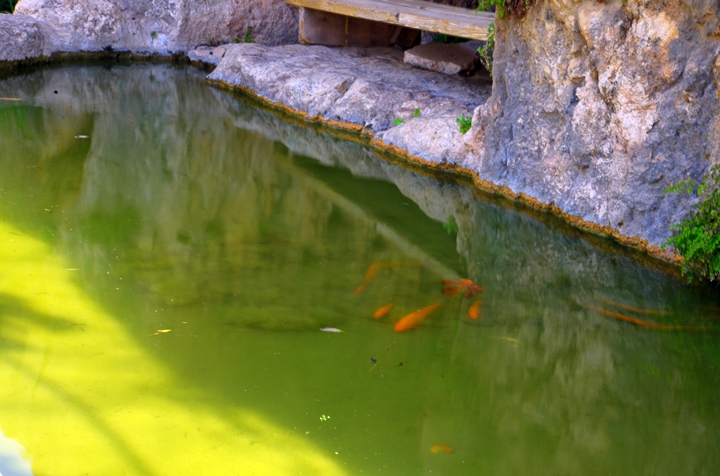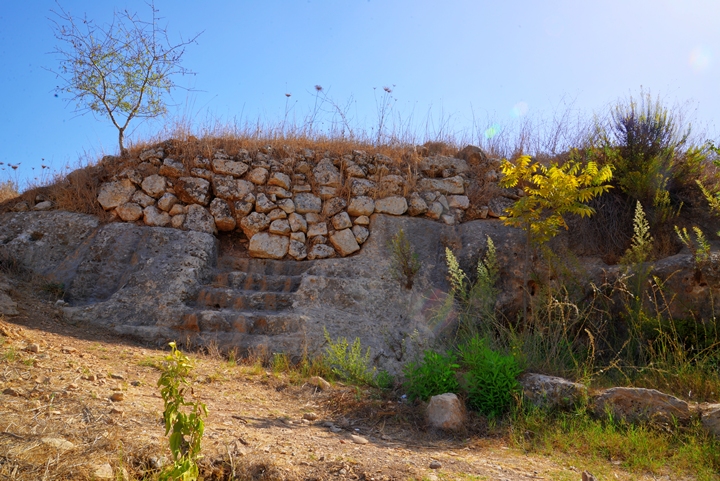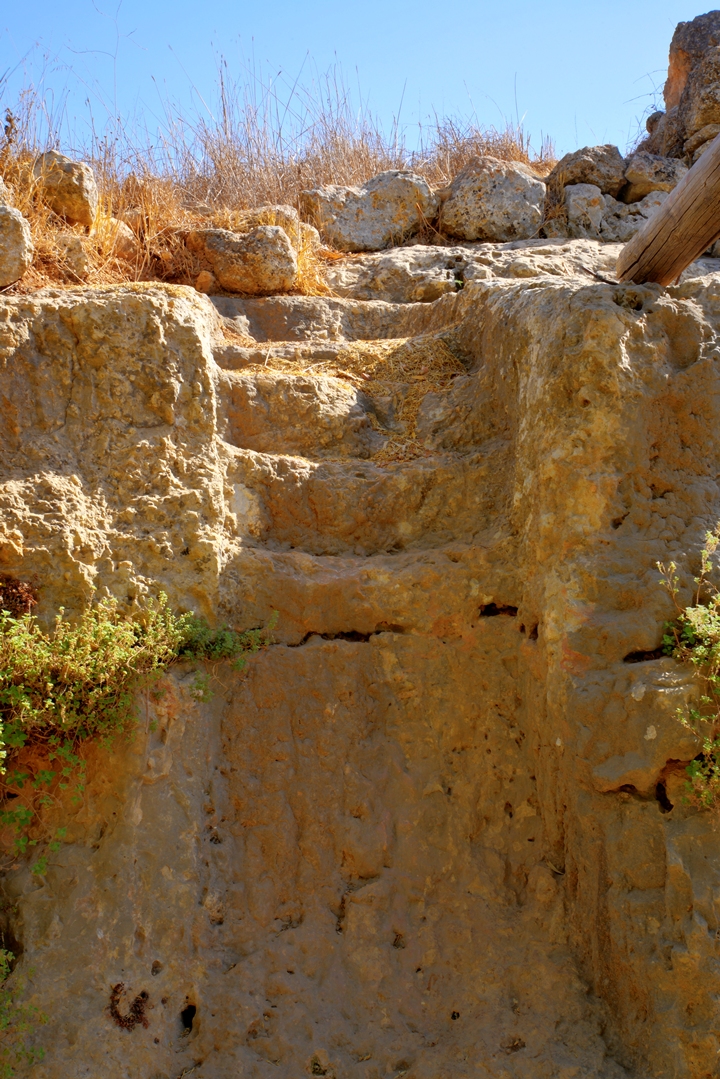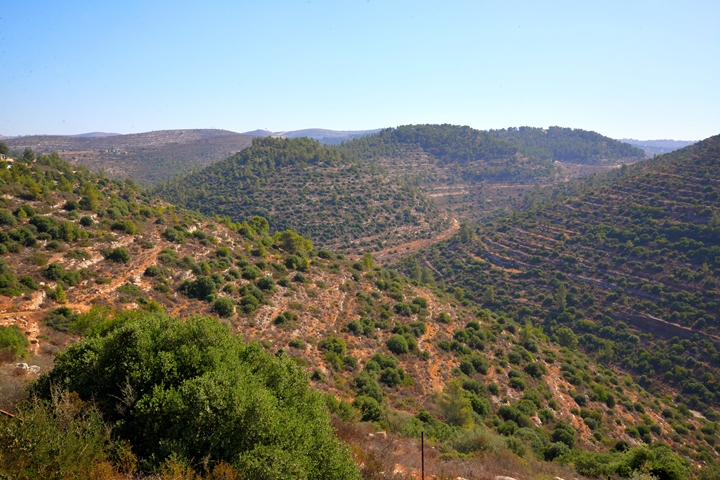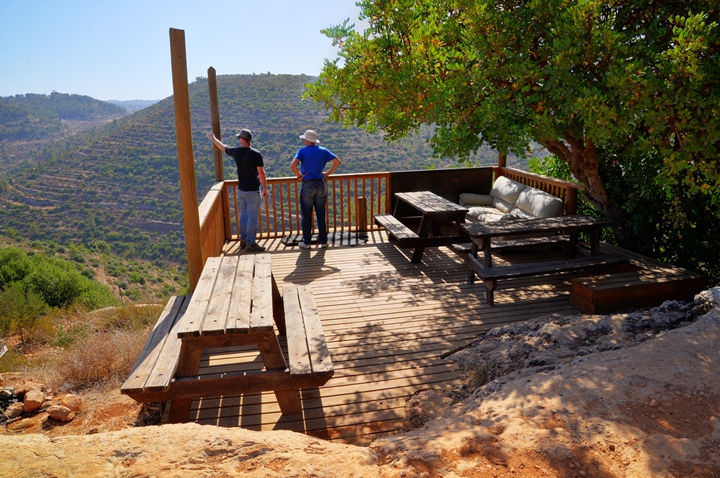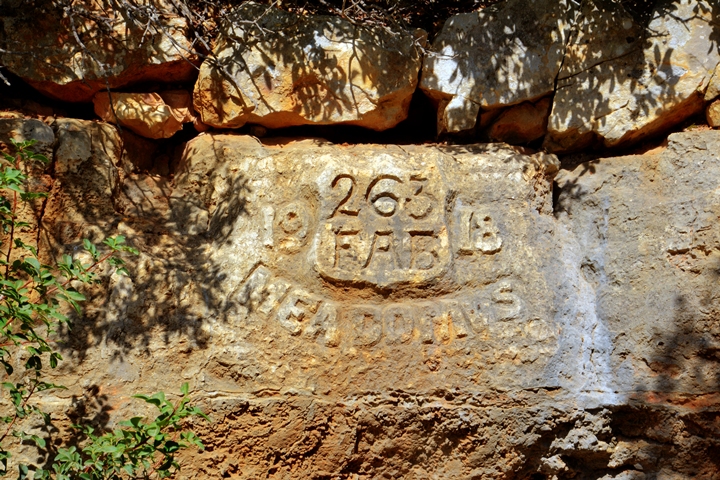Ancient winery complex, oil presses, tombs and spring in and around the community of Halamish/Neveh Tzuf.
* Site of the Month Mar 2019 *
Home > Sites > Samaria > South West > Halamish (Neveh Tzuf)
Contents:
Background
Location
History
Photos
* Huvlata
* Wineries
* Oil presses
* Miqveh
* Tombs
* Other
* Meir Spring
* Inscription
Etymology
Links
Overview:
The community of Halamish, also known as Neveh Tzuf, is located in the hill country of Ephraim. This web page reviews the ancient sites inside and near the community.
Location and Map:
The map shows the area around Halamish/Neveh Tzuf. In the center of the community is the ancient site of Huvelta (Kh. Hablata), on top of a hill (575m altitude, 70m above the valley). Other points of interest are Meir spring in the valley north of Halamish, and a WW1 inscription east of the community.
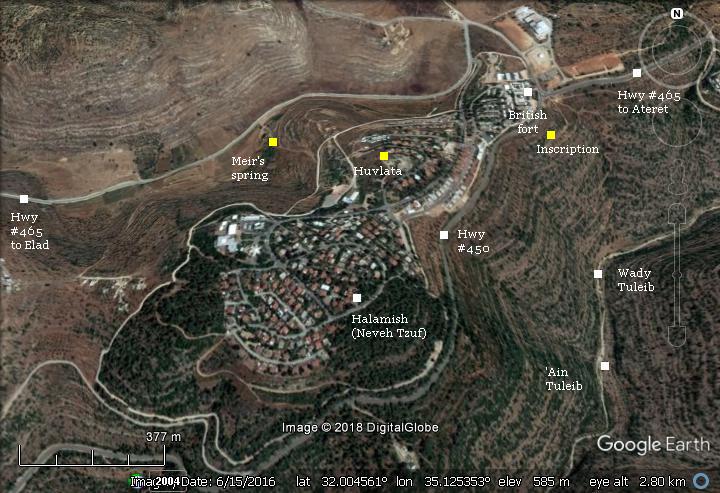
History:
- Hellenistic/Roman/Byzantine/Early Arab periods
The industrial area on top of the Huvelta hill was first in use during the Hellenistic/Roman period. It continued to manufacture wine and oil until the Early Arab period.
A Biblical map is shown here. An ancient route, indicated by a dashed line, passed on the north side of the site (marked with a red circle in the center, east of Thamnatha/Tibneh). That route connected the Shephela to the hills of Samaria, via Gophna.
Roads and cities during the Israelite period thru the Hasmonean period, 12th- 1st century BC (based on Bible Mapper 3.0)
- Ottoman period
Conder and Kitchener surveyed this area during the Survey of Western Palestine (SWP) in 1873. A section of their map (of sheet 14) is shown here.
The site does not appear on the map. Its location is in the center of the section, near a spring called ‘Ain W. Reiya. A Roman road (double dashed line) appears crossing from left to right, passes near the spring. On the same route is the modern road (Hwy #465).
To the north is the Arab village of Neby Saleh, and in the south west is another village – Deir en Nidham.
Part of maps Sheet 14 of Survey of Western Palestine,
by Conder and Kitchener, 1872-1877.
(Published 1880, reprinted by LifeintheHolyLand.com)
- Modern Period
The community was established in 1977. A group of 40 families moved into the abandoned British fort. Today (2018) the population reaches 1,500 residents.
In archaeological surveys and excavations conducted in 1997, a large industrial area was found inside the community of Halamish. The installations included a double oil press, a large scale winery, a ritual bath (Miqveh) and a lime kiln.
Photos:
(a) Huvelta site entrance
The ruins of Khirbet Hablata, also known as Huvelta, is located inside Halamish on a hill. According to the archaeological survey, based on ceramics and coins collected in the area, the site was occupied from the Hellenistic-Roman periods up to the Early Arab period.
Click on the photos to view in higher resolution…
A path leads up to the ancient agriculture area.
On the top of the hill is a large rock surface. As it was not useful for planting crops, the rock was used to curve installations – winepresses, tombs and ritual bath.
To the side of the surface is a raised platform.
(b) Wineries
On the hard surface are 16 round shallow installations arranged in a tight formation. Each of this circles have an average diameter of 2.3m and a depth of up to 10cm.
Each round surface inclines towards a cup cut into the surface, with a diameter of up to 0.75m and depth of 0.4m. These cups were used to collect the juice from the round surfaces.
This large scale cluster is unique, as only in a few locations in the Holy Land there were few similar formations.
There were several hypothesis suggested on the purpose of these installations, such as the production of wine or olive oil, installations for drying fruits, or used to produce dye.
Another research (Zohar Amar 2011) suggested that the installations were used to produce sweet wine. The process is based on having laying the grapes flat on the surface and having the sun cook them for about 3 days, then crushing them. This process increases the sweetness of the wine.
This wine is known as ‘Elliston’ or ‘Ellioston” in the Jewish Mishnah (Masekhet Menakhot 8:6): “…do not bring Ellioston (wine) and if bring – Kosher”. The word is based on the Greek word for ‘cooking by sun’ – Helliaston.
On the nearby surface is another installation – a twin Treading floors connected together in series by a single canal. The floors were paved with mosaic stones.
Here, the grapes were laid and crushed by the feet of the workers, extracting the juice. The juice then flowed along the canal to a collection pool. The pool, however, did not survive. Nearby is another cavity where the grapes were brought in from the vineyard and piled. There are also incomplete sections of other cavities of additional treading floors.
(c) Oil production
Samaria was one of the most fertile areas of olive cultivation and oil production in antiquity, and so hundreds of ancient oil presses were found in the area. In archaeological surveys and excavations conducted in 1997, a large industrial area was found in the community of Halamish. A double oil press was found nearby, and its major elements were assembled and are on display near the ancient winery.
Some notes on the oil press:
During the Byzantine/Early Arab period, a new pressing method was introduced that increased the output of the olive oil production. It was based on a lever, screw and cylindrical weight. This type of oil press is termed “lever-screw-and weight” type (“type 6”), and was the most widespread method found in the Holy Land.
A wooden lever was held on its two edges by a niche in the wall and a screw installation on its other end above the weight. The wooden screw was connected to the side of the weight, held upright by the twin mortises (cavities) on its side. The weight, normally weighing between 1.5 to 4 tons, forced the lever down when the screw was tightened up. The lever pushed down the baskets of olives which were placed on top of the basin. The extracted oil then poured out of the outlet into a collecting vat.
The double oil press installation, which was excavated nearby, included a single crushing basin that supported both oil presses in the first phase of production, where the olives were crushed. The second production phase used a lever and screw. Each of the oil presses used two types of screw weights – one cylindrical and one square.
These elements are seen below – the screw base with a cavity on the left, the square weight in the center, and the crushing basin and rolling stone 0n the right.
Another view of the elements is seen in the next photo. The crushing basin in the center, and the square weight on the left.
The oil press was in use starting from the Hellenistic/Roman period, and operated until the Early Arab period. Most of the ceramics collected in the installation dates to the 7th-8th century AD – the Early Arab Umayyad and early Abbasid periods. Note that Arabs are forbidden on drinking alcohol, therefore the agriculture production shifted from making wine to producing olive oil.
(d) Miqveh
According to Jewish tradition, the vinedressers (workers responsible for producing the wine), and the workers of the olive oil, had to purify themselves in a ritual bath for producing Kosher wine or oil. Such ritual bath (Hebrew: Miqveh) was cut into the rock near the installations.
The water inside the Miqveh stored runoff rain water. Several stairs lead down into a pool, where the worker would have purify himself.
(d) Tombs
A number of rock hewn burial caves are located nearby. The opening of the tomb is rectangular, leading to dual chambers on both sides.
Another rock hewn tomb is seen in the next photo.
(e) Other points of interest
A lime kiln is located near the entrance. It was used to burn limestone in order to produce Calcium oxide (aka, quicklime or burnt lime). The lime was then used as a sealant to cover the surfaces of the cisterns, thus preserving the water in the reservoirs. It was also used as a key ingredient for making cement.
An illustration of a lime kiln, dated 1882, is shown here. This is from a book by CH. W. Wilson , one of the PEF explorers. (The lime kiln was illustrated in the valley of Berachah, between Tekoa and the road from Hebron to Bethlehem).
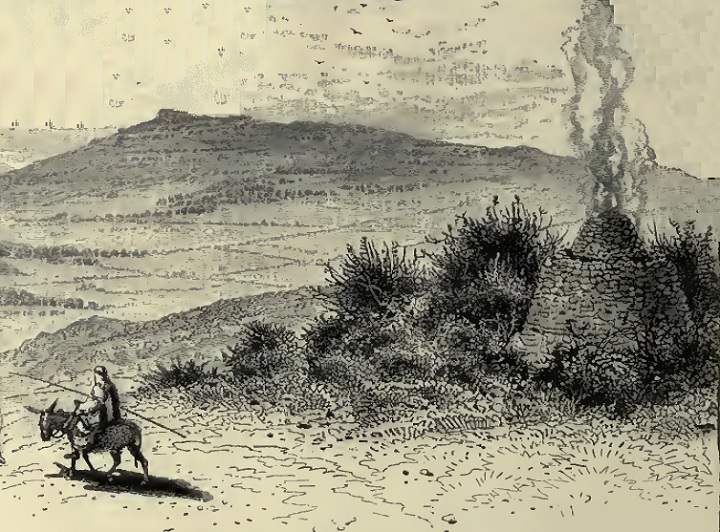
Ch. W. Wilson, Picturesque Palestine, 1882, Vol III P. 184
On the top of the hill are remains of modern military fortifications.
(f) Meir spring (Ein el Qas)
The valley on the north side of Halamish, where the modern highway #465 passes, is called Wadi Reiya. Along the valley are a number of springs: Ein al Qas , Ein Khalid, and Ein Reiya. In ancient times the Roman road passed along this valley, connecting the Shephela to the hills of Samaria, via Gophna.
In the left background is the Arab village of Deir en Nidham (meaning: the “monastery of the marshal”). On the hill in the center of the background are the ruins of Kh. Tibneh – identified as Timnath-Serah or Timnath- Heres- the burial-place of Joshua according to the Bible.
Meir spring is located on the north west foothills of Halamish. The entrance to the place is on the side of the highway.
The name of the spring in Arabic is al-Qas (also: el-Qos). In Hebrew it is named after the late Meir Segal, one of the founders of Halamish/Neveh Tzuf.
The residents of Halamish prepared a nice garden around the spring. A really nice oasis….
The waters of the spring are collected into a pool.
The source of the spring is from the cave, seen here behind the small pond.
There are also goldfish in the pond:
There are steps cut into the rock, but are now blocked by a wall of stones.
Another rock hewn staircase closer to the spring:
(g) Overlooking the valley
Halamish overlooks the valley of Wadi Tuleib on its south and east sides. There is 110m drop in height from this point to Tuleib spring at the the bottom of the valley.
An observation point and orchard was constructed here, commemorating Erez S. Rond. Erez, age 18, was murdered in 2002 while driving from his home in Ophra to Shiloh.
During WW1 (Nov 19-21 2017) the British forces (under General Allenby) attacked the area controlled by the Turks and Germans in the Judean hills, prior to the conquest of Jerusalem. Some of the soldiers were then stationed here during the following winter time.
A marking of a British soldier was engraved on stone behind the memorial orchard. It reads Mea Domus (Latin: “My home”) and “263 FAB” meaning the Field Artillery Brigade 263rd, which was attached to the 10th (Irish) Division.
Etymology (behind the name):
* Names of the site and vicinity:
- Khirbet Hablata – the name as appears in the British map; perhaps based on the Arabic word Habla – means vine.
- Huvelta – modern name of the site;
- Halamish – Hebrew for: flint. Psalms 114:8: “Which turned the rock into a standing water, the flint into a fountain of waters.”.
- Neby Saleh – Arabic: The “righteous prophet”. Saleh (also Salih) was a pre-Islamic prophet in Arabia, mentioned in the Quran.
- Deir en Nidham – Arabic: the “monastery of the Marshal”.
Links and References:
* External:
- On Halamish-Neveh Tzuf wineries – Amar Zohar (Hebrew, pdf, 2011, p/o Ma’abeh Hahar articles)
- How Jerusalem was won – WT Massey, 1919 – WW1 history
- 263 FAB addresses the identity of this WW1 brigade
* Info sites:
* BibleWalks nearby sites:
- Tibneh – identified as Timnath-Serah or Timnath- Heres- the burial-place of Joshua according to the Bible.
- Samaria – Gallery of sites
BibleWalks.com – tour the Bible Lands
Ein Bubin <<<—previous Samaria site—<<<All Sites>>>—next Samaria site—>>> Zereda
![]()
This page was last updated on Apr 17, 2020 (Add lime kiln illustration)
Sponsored links:
